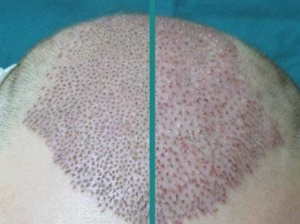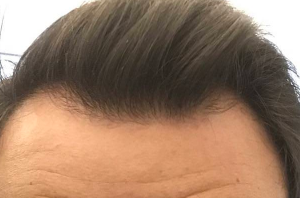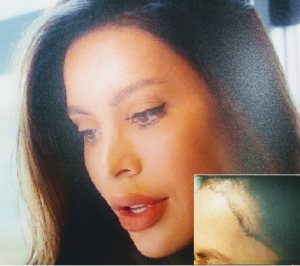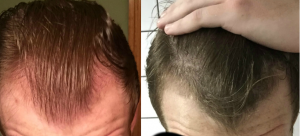A clinic posted two pictures and labeled one as theirs and the other as the competitor. What you are looking at nothing more that two examples of different hair transplant densities. The one on the left had twice the density as the man on the right and probably paid twice the cost. The advertising is clearly misleading and I suspect that it was a set-up because both sides look like different sides of the same patient. The surgeons then would have added more density after the photo on the right was taken so as not to victimize his patient.
I fished up a photo from the internet of a patient that had FUE grafts in the frontal recipient area. Two things worth noticing: (1) the grafts are elevated and (2) there is skin in the graft that is as wide as the graft itself.
The skin will survive the transplant and the elevation will produce small, subtle white elevated bump surrounding each group of hair from the recipient area (called cobblestonning) and I believe that is what you may be seeing.
I do this differently than the doctor who did the patient in the photo, as I trim off the skin of the grafts before placing them and then place the grafts flush with the surrounding skin so that these white area are not present in our grafts. Click on the photo to enlarge it.
DHT is a byproduct of testosterone metabolism and is a critical hormone for establishing male characteristics. No diet can’t change your DHT levels
https://medicalxpress.com/news/2018-05-finasteride-prostate-cancer-death.html
With almost 300,000 person-years of follow-up and a median follow-up of 18.4 years, they found 42 deaths due to prostate cancer on the finasteride arm and 56 on placebo.
I write against hair transplants for 22 year old men. I think long-term on everyone and no matter what you may look like at 22, your hair loss WILL get worse in the next few years because genetic hair loss in 22 year old men is progressive and often aggressively so. You had 2800 grafts, that is possibly 35-40% of your total donor supply (depends on donor density) so what you have left in the donor area is ALL you have left to follow further balding as this WILL happen in the next few years. I wait until my patients are at least 25-26 before offering a hair transplant and I speak about this philosophy at medical meetings and I can tell you my views are not in the minority. It may be important for the readers to know that I make my living doing surgery so when I turn down a 22 year old, I do it for a reason and it is not for my financial benefit, but rather for the benefit of the patient. I have seen too many young men get surgery too young, and almost 100% of them regret the decision years later. The surgery commits them to years of more surgeries and possibly never looking normal if they run out of donor hair before their balding stops. I am very big on a Master Plan for all men I transplant which takes into account the progressive process of genetic hair loss that is close to 100%. I hope I am wrong on this one young man!
This man (in the following post), had he been transplanted with 2800 grafts at 22, would maybe not look normal at 35 and for the older man in these photos, he certainly would have a problem with all of his donor area used up in his 20s. https://baldingblog.com/need-master-plan-think-hair-transplants-photos/. In my many years in practice, I push for being conservative and not pushing surgeries until the patient is old enough and has a Master Plan worked out with me.
(Comment: For some reason, the person who posted this thread on Reddit took it down. Essentially he discussed his experience with deciding on (1) getting a hair transplant, (2) the surgery and (3) the immediate post-operative recovery. The entire post was a short term: https://www.reddit.com/r/tressless/comments/auux3x/received_a_hair_transplant_today_at_22_years_old/ narrative and that was my problem with it as you can see in the link I posted which shows what happens to many young men as they get older and if they rush into a hair transplant surgery, they may have regrets if and when the balding accelerates. Yesterday, I took care of a patient who had hair transplants in the 1980s when he was also very young, and I have been trying to make him normal ever since I first met him in 1995 when he came to see me looking like a mess, heavily scarred and deformed by the poor quality of the 1980’s work he had done and the progressive nature of his balding which left him with very little hair to work with.)
There are no reports of finasteride in men cross to the women through semen and as a result there are no reports of abnormal sexual identification of children born to men’s wives when the men have taken the finasteride while conceiving.
Rather than obsess over your situation, meet with a doctor who is in this field of hair restoration and start building a Master Plan for your hair loss. I usually start by performing a HAIRCHECK instrument test on my patients to determine a baseline for the hair loss. Then, I start medications which would be appropriate for someone of your age. I follow the progress over a year or two. If the balding continues and gets worse, I might then consider a hair transplant but I must know you and you should get to know and trust your doctor over that time he treats you with medications. With trust, you can get your hair back and address your depression by taking action.
Balding gave me the final punch into depression, who else? from tressless
Balding so young, I feel like genetic trash. People treat me differently too, well they did. I got some regrowth and it’s absolutely disgusting how people treat you better when you improve your looks. Looks are everything. Anyways, I want to be hopeful for the “treatments” of the future, but history tells us a different story of hope then disappointment, as seen by browsing hair loss forums years ago. Everyone at my college has a thick NW1. Not one balding man. It’s rare this young. I have realized I am subhuman trash, I know my place now. If I ever go completely bald (I probably will) it’s game over.
You should see a doctor and you can probably address your problem, one way or the other. There are many good solutions including medications, Scalp Micropigmentation or hair transplantation. If I were to see you, I would work to get you to manage your hair loss in a productive way. My consultations are free and you can contact me over the internet at wrassman@newhair.com and send photos along with the email.
As men get older, their testosterone often drops along with the DHT levels in their blood. That is why balding reduces. Actually, when DHT levels are the highest in your teens and early 20s, the impact of the DHT on genetic balding is highest also?. For women it works in the reverse because the high estrogen levels of fertile females, counter balances any androgen (testosterone is an androgen) her body produces and genetic balding it put at bay.
The important take-away here is that within 4 days, with proper washing techniques, there is no scabbing present and nothing detectable short of a little tinge of pinkish color if you look close. All patients having a hair transplant should look like this within 4 days of the transplant. Some of the hairs that were placed already have shed so you can see why it is impossible to count the grafts after a few days.

Few, if any of our baldingblog readers, may know the name, but this is the man who was the ‘inventor’ of modern hair transplantation in the 1950s. What he taught us, was the hairy skin taken from the back and side of the head, when placed in a bald area, would grow the hair and not be impacted by the balding. He called that ‘Donor Dominance’ and the rest is history. It took almost a decade for the journals, the dermatologists of the time and the medical establishment to accept his pioneering discovery, but because of his discovery, we have possibly a $10 Billion hair transplant business world-wide today that helps hundreds of thousands of people. Read about him in the New York Times here: https://www.nytimes.com/2019/02/21/business/dr-norman-orentreich-dead.html?fbclid=IwAR00A3NAeWyZsU-cLcT288mVH_0dG8u6H-qmpyxDss7fpfG-lEy_8lUmrvY







